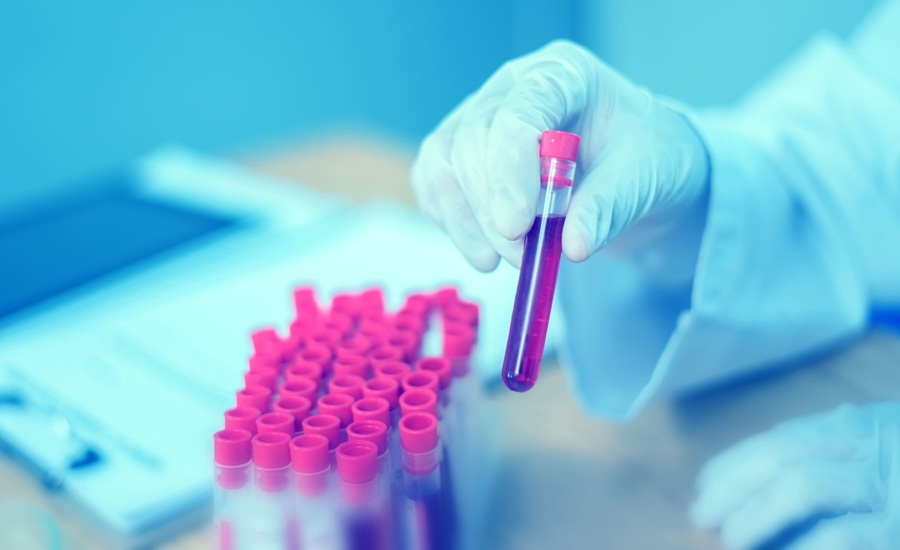Patch Painlessly Tests for Glucose in Diabetics
|
By LabMedica International staff writers Posted on 05 May 2009 |
A skin patch could one day provide a less-invasive alternative for diabetics who need to take regular samples of their own blood to keep glucose levels in check.
The patch, approximately the size of a deck of cards, contains four micro-needles that "bite" sequentially at programmed intervals. The needles are electronically controlled to penetrate the skin deep enough to draw blood from a capillary, but not deep enough to hit a nerve. This means patients would experience little or no pain. The patch could be worn anywhere on the body where it could obtain accurate readings of capillary blood.
Electrical engineers from the Schulich School of Engineering at the University of Calgary (Alberta, Canada) have patented the device, which they dubbed the Electronic Mosquito. A sensor in each cell of the e-Mosquito measures sugar levels in the blood. These data can then be sent wirelessly to a remote device such as a computer or a monitoring instrument worn on the wrist. The system could even be connected to an alarm to alert patients or doctors when blood sugar levels enter the danger zone. The currently used method of drawing blood from fingertips and using glucose-testing strips can be painful, inconvenient, and time-consuming.
"This is a dramatic improvement over manual poking, particularly for children and elderly patients," said Martin Mintchev, director of the Low Frequency Instrumentation Lab at the Schulich School of Engineering. "Our approach is radically different and offers a reliable, repeatable solution with the minor inconvenience of wearing something similar to an adhesive bandage."
Eventually, the biomedical engineers intend to integrate a pump system so insulin injections can also become autonomous based on data from the e-Mosquito, thus converting the device into an external artificial pancreas.
Approximately 246 million people around the world are affected by diabetes. More than two million Canadians have diabetes, a number that is increasing because of the aging population and rising obesity rates, according to the Canadian Diabetes Association.
Related Links:
Schulich School of Engineering at the University of Calgary
The patch, approximately the size of a deck of cards, contains four micro-needles that "bite" sequentially at programmed intervals. The needles are electronically controlled to penetrate the skin deep enough to draw blood from a capillary, but not deep enough to hit a nerve. This means patients would experience little or no pain. The patch could be worn anywhere on the body where it could obtain accurate readings of capillary blood.
Electrical engineers from the Schulich School of Engineering at the University of Calgary (Alberta, Canada) have patented the device, which they dubbed the Electronic Mosquito. A sensor in each cell of the e-Mosquito measures sugar levels in the blood. These data can then be sent wirelessly to a remote device such as a computer or a monitoring instrument worn on the wrist. The system could even be connected to an alarm to alert patients or doctors when blood sugar levels enter the danger zone. The currently used method of drawing blood from fingertips and using glucose-testing strips can be painful, inconvenient, and time-consuming.
"This is a dramatic improvement over manual poking, particularly for children and elderly patients," said Martin Mintchev, director of the Low Frequency Instrumentation Lab at the Schulich School of Engineering. "Our approach is radically different and offers a reliable, repeatable solution with the minor inconvenience of wearing something similar to an adhesive bandage."
Eventually, the biomedical engineers intend to integrate a pump system so insulin injections can also become autonomous based on data from the e-Mosquito, thus converting the device into an external artificial pancreas.
Approximately 246 million people around the world are affected by diabetes. More than two million Canadians have diabetes, a number that is increasing because of the aging population and rising obesity rates, according to the Canadian Diabetes Association.
Related Links:
Schulich School of Engineering at the University of Calgary
Latest Clinical Chem. News
- VOCs Show Promise for Early Multi-Cancer Detection
- Portable Raman Spectroscopy Offers Cost-Effective Kidney Disease Diagnosis at POC
- Gold Nanoparticles to Improve Accuracy of Ovarian Cancer Diagnosis
- Simultaneous Cell Isolation Technology Improves Cancer Diagnostic Accuracy
- Simple Non-Invasive Hair-Based Test Could Speed ALS Diagnosis
- Paper Strip Saliva Test Detects Elevated Uric Acid Levels Without Blood Draws
- Prostate Cancer Markers Based on Chemical Make-Up of Calcifications to Speed Up Detection
- Breath Test Could Help Detect Blood Cancers
- ML-Powered Gas Sensors to Detect Pathogens and AMR at POC
- Saliva-Based Cancer Detection Technology Eliminates Need for Complex Sample Preparation
- Skin Swabs Could Detect Parkinson’s Years Before Symptoms Appear
- New Clinical Chemistry Analyzer Designed to Meet Growing Demands of Modern Labs

- New Reference Measurement Procedure Standardizes Nucleic Acid Amplification Test Results
- Pen-Like Tool Quickly and Non-Invasively Detects Opioids from Skin
- Simple Urine Test Could Detect Multiple Cancers at Early Stage
- Earwax Test Accurately Detects Parkinson’s by Identifying Odor Molecules
Channels
Molecular Diagnostics
view channel
DNA Sensor Enables Molecular Detection from Single Blood Drop
Accurately monitoring drug levels in patients’ blood remains a major challenge in modern medicine. Each patient’s pharmacokinetic profile varies, leading to inconsistent drug exposure — underdosing can... Read more
DNA-Powered Test Accurately Detects E. Coli Lookalike Bacteria
Accurately diagnosing bacterial infections remains a major clinical challenge, particularly when genetically similar species mimic one another. Such is the case with Escherichia marmotae, a bacterium often... Read moreHematology
view channel
Viscoelastic Testing Could Improve Treatment of Maternal Hemorrhage
Postpartum hemorrhage, severe bleeding after childbirth, remains one of the leading causes of maternal mortality worldwide, yet many of these deaths are preventable. Standard care can be hindered by delays... Read more
Pioneering Model Measures Radiation Exposure in Blood for Precise Cancer Treatments
Scientists have long focused on protecting organs near tumors during radiotherapy, but blood — a vital, circulating tissue — has largely been excluded from dose calculations. Each blood cell passing through... Read more
Platelets Could Improve Early and Minimally Invasive Detection of Cancer
Platelets are widely recognized for their role in blood clotting and scab formation, but they also play a crucial role in immune defense by detecting pathogens and recruiting immune cells.... Read more
Portable and Disposable Device Obtains Platelet-Rich Plasma Without Complex Equipment
Platelet-rich plasma (PRP) plays a crucial role in regenerative medicine due to its ability to accelerate healing and repair tissue. However, obtaining PRP traditionally requires expensive centrifugation... Read moreImmunology
view channel
Molecular Microscope Diagnostic System Assesses Lung Transplant Rejection
Lung transplant recipients face a significant risk of rejection and often require routine biopsies to monitor graft health, yet assessing the same biopsy sample can be highly inconsistent among pathologists.... Read more
Blood Test Tracks Treatment Resistance in High-Grade Serous Ovarian Cancer
High-grade serous ovarian cancer (HGSOC) is often diagnosed at an advanced stage because it spreads microscopically throughout the abdomen, and although initial surgery and chemotherapy can work, most... Read more
Luminescent Probe Measures Immune Cell Activity in Real Time
The human immune system plays a vital role in defending against disease, but its activity must be precisely monitored to ensure effective treatment in cancer therapy, autoimmune disorders, and organ transplants.... Read more
Blood-Based Immune Cell Signatures Could Guide Treatment Decisions for Critically Ill Patients
When a patient enters the emergency department in critical condition, clinicians must rapidly decide whether the patient has an infection, whether it is bacterial or viral, and whether immediate treatment... Read moreMicrobiology
view channel
Fast Noninvasive Bedside Test Uses Sugar Fingerprint to Detect Fungal Infections
Candida bloodstream infections are a growing global health threat, causing an estimated 6 million cases and 3.8 million deaths annually. Hospitals are particularly vulnerable, as weakened patients after... Read more
Rapid Sepsis Diagnostic Device to Enable Personalized Critical Care for ICU Patients
Sepsis is a life-threatening condition that occurs when the body’s response to infection spirals out of control, damaging organs and leading to critical illness. Patients often arrive at intensive care... Read morePathology
view channel
AI Improves Cervical Cancer Screening in Low-Resource Settings
Access to cervical cancer screening in low- and middle-income countries remains limited, leaving many women without early detection for this life-threatening disease. The lack of access to laboratories,... Read more
New Multi-Omics Tool Illuminates Cancer Progression
Tracking how cancers evolve into more aggressive and therapy-resistant forms has long been a challenge for researchers. Many current tools can only capture limited genetic information from tumor samples,... Read moreTechnology
view channel
Viral Biosensor Test Simultaneously Detects Hepatitis and HIV
Globally, over 300 million people live with Hepatitis B and C, and 40 million with HIV, according to WHO estimates. Diagnosing bloodborne viruses such as HIV and Hepatitis B and C remains challenging in... Read more
Acoustofluidic Device to Transform Point-Of-Care sEV-Based Diagnostics
Rapid and sensitive detection of small extracellular vesicles (sEVs)—key biomarkers in cancer and organ health monitoring—remains challenging due to the need for multiple preprocessing steps and bulky... Read moreIndustry
view channel
Advanced Instruments Merged Under Nova Biomedical Name
Advanced Instruments (Norwood, MA, USA) and Nova Biomedical (Waltham, MA, USA) are now officially doing business under a single, unified brand. This transformation is expected to deliver greater value... Read more







 Analyzer.jpg)

 assay.jpg)






